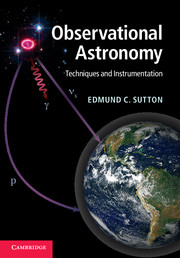Book contents
- Frontmatter
- Contents
- List of illustrations
- List of tables
- Preface
- Acknowledgements
- 1 Astrophysical information
- 2 Photometry
- 3 Positional astronomy
- 4 Fourier transforms
- 5 Detection systems
- 6 Orthodox statistics
- 7 Stochastic processes and noise
- 8 Optics
- 9 Interference
- 10 Spectroscopy
- 11 Ultraviolet, x-ray, and gamma ray astronomy
- 12 Radio receivers, spectrometers, and interferometers
- 13 Modern statistical methods
- 14 Neutrino detectors
- 15 Cosmic ray detectors
- 16 Gravitational waves
- 17 Polarimetry
- Appendix A Physical constants and units
- Appendix B Acronyms
- Appendix C Additional reading
- References
- Index
- Plates
16 - Gravitational waves
Published online by Cambridge University Press: 05 June 2012
- Frontmatter
- Contents
- List of illustrations
- List of tables
- Preface
- Acknowledgements
- 1 Astrophysical information
- 2 Photometry
- 3 Positional astronomy
- 4 Fourier transforms
- 5 Detection systems
- 6 Orthodox statistics
- 7 Stochastic processes and noise
- 8 Optics
- 9 Interference
- 10 Spectroscopy
- 11 Ultraviolet, x-ray, and gamma ray astronomy
- 12 Radio receivers, spectrometers, and interferometers
- 13 Modern statistical methods
- 14 Neutrino detectors
- 15 Cosmic ray detectors
- 16 Gravitational waves
- 17 Polarimetry
- Appendix A Physical constants and units
- Appendix B Acronyms
- Appendix C Additional reading
- References
- Index
- Plates
Summary
Few physicists today doubt the reality of gravitational radiation. The existence of gravitational waves is a firm prediction of the theory of general relativity, and gravitational radiation is observed indirectly through the energy loss and decreasing orbital period of the Hulse–Taylor binary pulsar system PSR J1915+1606 (Hulse & Taylor, 1975). Observing gravitational radiation directly would certainly be a further confirmation of general relativity. But more importantly, observations of gravitational radiation will enable us to determine properties of regions and of times for which we otherwise have little information.
The pioneering work of Joseph Weber using resonant bar detectors (Weber, 1966) is of great importance in this field and has inspired much of the observational work that followed. Most books and reviews on gravitational wave detection begin with a discussion of Weber bars. In this chapter we concentrate on interferometric detectors, which seem at this time to hold the greatest promise for detecting gravitational waves.
Characteristics of gravitational radiation
Gravitation is described in the field equations of general relativity as curvature of space-time. In quantum field theory the mediator of the gravitational interaction is thought to be the massless, spin-2 graviton. In the classical limit these formulations are equivalent. Both predict the existence of gravitational radiation which is quadrupolar in nature.
In a linearized theory, gravitational waves in free space are described as small perturbations hμν on the Minkowski flat space-time metric.
- Type
- Chapter
- Information
- Observational AstronomyTechniques and Instrumentation, pp. 314 - 339Publisher: Cambridge University PressPrint publication year: 2011



